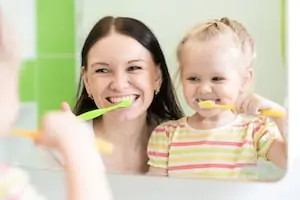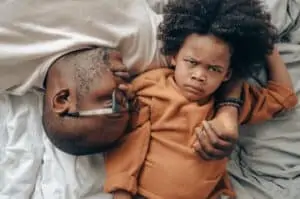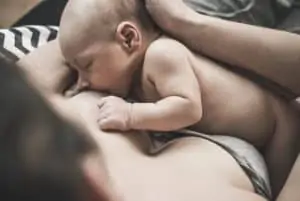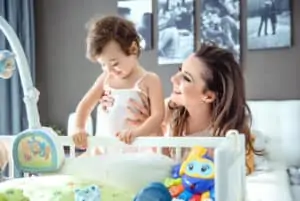Last night at bedtime, I walked down the hall to find both of my daughters brushing. They flossed and rinsed with kid-friendly mouthwash too. I smiled at the sight, for it wasn’t that long ago that these two made me nuts when it was time to brush their teeth as toddlers.
If your toddler refuses to brush teeth, you’re not alone. You’re in very good company, Mama! It seems to be that every toddler hates brushing their teeth. But if you’re not brushing your toddler’s teeth by the age of 1, or even 18 months, it’s time to start. This way, when they’re 2 years old, your toddler struggles to brush teeth issues may be nonexistent.
Teach a kid to brush their teeth properly, and you’ll likely have less dental woes down the road. I know, I know…trying to tell a toddler who is likely already afraid of ever seeing a dentist about the problems that can arise from not brushing just won’t work.
So, what can you do?
Not to worry, Mama, as I’ve got you covered. I’ve got tips for brushing toddler teeth. Even when your 18-month old won’t let you brush her teeth, you’ll soon know how to conquer it.
I think my eldest was about 18 months, maybe even 2 years old, when we started having her do it herself rather than one of us doing it for her. She was so proud; only she was brushing her lips. When we told her that brushing her lips was not the same as brushing her teeth, she started laughing hysterically.
“Brush your lips!” She sang out jubilantly. My husband poured me another glass of wine. Good man.
In any event, the earlier you start, the better your child’s oral health will be. So, let’s get down to it, and you’ll soon know how to brush a stubborn toddler’s teeth!
When to start brushing baby gums?
When my first daughter was born, my breastfeeding coach I always speak of, Vivien, told me I should clean her gums after feedings. This is in line with what pediatric dentists recommend.
Nursing or bottle-feeding means bacteria growth will develop. Yes, even if there aren’t any teeth!
But babies with no teeth can have their gums cleaned with a soft, clean, and damp cloth. You can also use a silicone finger brush if you’d prefer. These are gentle and sterile options that can even be soothing for when teething begins.
If your baby gets a tooth (or more than one!) in that first year, you’ll want to brush that too. A baby toothbrush can help you with that too. You can use just plain water or a smear of fluoride toothpaste. I’ll have more specific tips about toothpaste portions further below.
Toothbrushes for babies and toddlers need to be soft-bristled, never hard. If you are given a gift of baby toothbrushes, make sure they are soft enough. Also, make sure if they have any rough edges or you have used them for more than 2 to 4 months that you throw them away and replace them.
When to start brushing toddler teeth?
If you haven’t been brushing your one-year-old’s teeth and they get a tooth, the time to start is now. My eldest didn’t get her first tooth until just after her first birthday. My youngest got hers before that. Whatever the case, it’s time to begin brushing that one precious tooth!

Even the American Academy of Pediatric Dentistry says that this is the time to start.
However, just because they say it’s time doesn’t mean your little one will agree. “My toddler won’t let me brush her teeth,” my cousin had messaged me. She asked me what to do about it, and with all the messages I’ve been getting around toddler teeth and brushing, I thought this was a fine time to discuss it.
The thing about it is your toddler won’t brush teeth on their own. You’ve got to devote time to this habit so they will know how to do it right for a lifetime. If you’ve ever had dental problems in your life, you surely don’t want the same problems to befall your child, so it is essential to get this habit built.
What happens if a toddler doesn’t brush teeth every day?
Tooth decay is something we tend to picture happening to an adult who doesn’t practice good oral hygiene. But guess what? It can happen to children too.
If your toddler doesn’t brush at all or isn’t brushing properly, they can have dental problems down the road. Improper brushing can make teeth hurt, and when that happens, your child may not chew well. When your child doesn’t chew food enough, poor digestion takes over.
And if you think, “So what? They’ll get permanent teeth soon,” think again! This can impact those permanent teeth that haven’t even come out of the gumline yet. It may also affect pronunciation and cause other problems for their oral health.
We all want the best for our kids. So, now the next phase in raising your child will involve a new struggle…brushing toddler’s teeth. And if you’ve tried to brush their teeth already but lost the battle, you’ll have to dust yourself off and get back to it. It won’t always be a struggle, and the tips you’ll find below will help you win!
How to brush your baby’s teeth when they refuse?
When it comes to babies, this is a bit harder. You may need to enlist the help of your spouse, another caretaker, or some friends. Whoever can help you, you’re going to need them.
The best way is to sit with another adult facing each other with your knees touching. You’ll place your baby so that she’s got the back of her head resting on one of your laps with the legs on the other lap. When done right, your child should be in a stable position that won’t let her fall.
Once you have the baby positioned, whoever has her head on their lap should gently lift your baby’s lips, so the gums and any teeth are visible. The other hand should be used to provide gentle brushing.
It should go without saying, but each of you should have freshly washed hands!
As for whoever is not tasked with the brushing, that person’s job is to distract and comfort the baby. Hold her hands to keep her from swatting at the toothbrush and keep a cheerful tone. In time, your baby will fuss less over this.
In fact, as she gets bigger, she may want to hold the toothbrush and try herself!
But Leslie, what if there’s no one around to help me?
I get you.
There was a time when my husband took a business trip while we were in China, and I was left all alone with my eldest. My in-laws had the troubling habit of always popping by, but they weren’t coming by until later that day. I simply did the steps above but held her in my own lap. I sat on the floor atop a mat to prevent her from falling, and all worked out fine.
How to brush a toddler’s teeth without a fight?
Ok, so we have covered brushing a baby’s teeth. But what about your toddler? When children reach 18 months and 2 years of age, they can go through a not-so-fun phase of refusing to brush their teeth—and refusing to allow you to do it too! Yay!
I do have good news, though, and it is this: it will NOT be a struggle forever. Kids need to get into routines, and it takes time. You can follow these tips for brushing toddlers’ teeth when your toddler won’t brush teeth!
Brush your teeth at the same time

I’ve mentioned it many times before, but it never hurts…kids copy what they see from us. So if you brush your teeth with your toddler, they will want to be like you. Act like you’re having fun, talk about how fresh your mouth feels, and narrate the experience.
Let them try it out
If you’re always brushing your 18 month old’s teeth, they may feel like they have no control. Children want to feel like they have a say in things, and they like to be hands-on. So let your child take a try. You can let them brush first and then finish the job or vice versa. Letting them do it and encouraging them to do so will lessen the battle of brushing.
Bring a stuffed animal along
My youngest is far more sensitive, so I invited her to bring one of her favorite stuffies along for brushing. She’d position it on the floor just outside the bathroom door, and I’d tell her to show Fluffy the Unicorn how she brushes her teeth. I also had her use a clean and dry toothbrush on Fluffy while I assisted with brushing her teeth.
Get teeth brushing books for toddlers
Any difficulty you have with your little one can probably be found in a book. We loved this Elmo book about brushing teeth. It’s a fun pop-up book that both my daughters really enjoyed.
Try teeth brushing songs for toddlers
I have always enjoyed making up silly songs, even at my age. So making up a song about brushing on the fly was fun for me. I know many moms and dads use “Row, Row, Row Your Boat” with lyrics changed for brushing purposes. But feel free to be creative. Anything that takes up 2 minutes is a great way to get things going.
And if your child is 3 years of age or older, you can try a musical electric toothbrush. Electric toothbrushes for children are great tools to ensure better brushing and better oral hygiene, but you should not give one to a child under 3. And when you give one to a child over 3, you must supervise the brushing!
Let your child choose their toothbrushing accessories
Now, because children don’t know the specs of what to look for with a proper toothbrush for their age, you will need to narrow it down to the proper selection. Once you do, have your child choose from an array of colors or designs in toothbrushes. This will make them more likely to want to brush with it.
Note that:
Toothpaste flavors tend to be more personal. My daughters both loved the bubble gum-style flavors, but they didn’t like it anymore as they got bigger. They tried berry flavors, and finally, now they enjoy the minty stuff. My suggestion is to get a few small toothpaste tubes for kids and see which flavor and brand they like best.
Reward good brushing
Another great way to encourage better brushing without battles is to get teeth brushing chart for toddlers. Something like this would be ideal, letting your child see their progress. You can decide on a reward together that provides motivation.
What else you need to know about teeth brushing for little ones
Before I end this topic, I have a few other quick things you need to know about brushing the teeth of any child under the age of 2:
- Only use toothpaste that states it can be used on children under 2.
- For children under 2, put the toothpaste on yourself. It should be about the size of a rice grain.
- Make sure your child spits the toothpaste out. This is why you must supervise brushing!
- Brush at least twice daily.
And for children over 2 but under 5, you can use a pea-sized dollop of toothpaste. You’ll still need to supervise, but things should be going much more smoothly by then!
Leslie Berry lives with her husband and two young daughters in Los Altos, California, where she loves helping other moms get comfortable with motherhood and embracing the insanity with facts peppered with laughs.
She loves eating too much sushi, exercising, and jamming out on her Fender. Read more about Leslie here.






